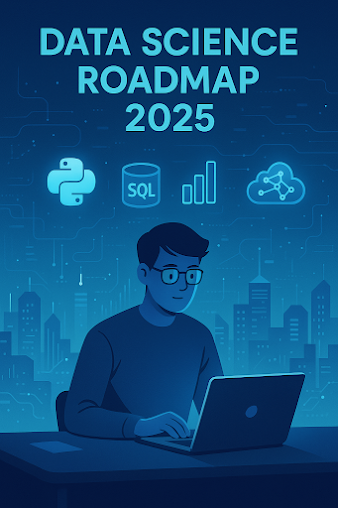Data Science Roadmap for Beginners (2025 Edition)
🧠 Data Science Roadmap for Beginners (2025 Edition)
🚀 Why Choose Data Science in 2025?
Data Science is one of the fastest-growing fields in 2025, with companies relying heavily on data to drive decisions. From AI to automation, every sector, including finance, healthcare, e-commerce, and education, depends on data. If you're a beginner eager to start your journey, this roadmap is tailored for absolute newbies with no prior coding or analytics background.
📌 Prerequisite: What You Need to Get Started
Before diving deep into data science, ensure you have:
-
Basic Math & Statistics (mean, median, mode, probability, linear algebra)
-
Computer Literacy
-
Curiosity and Logical Thinking
-
A stable internet connection and a laptop
📘 Step-by-Step Data Science Roadmap (2025)
1️⃣ Step 1: Learn Python – The Core Language
Tools: Jupyter Notebook, Anaconda, Google Colab
Key Concepts:
-
Variables, loops, functions
-
NumPy for numerical computing
-
Pandas for data manipulation
-
Matplotlib & Seaborn for visualization
📚 Recommended Resource: Python for Data Science on Coursera
2️⃣ Step 2: Master SQL – Talk to Databases
Topics to Cover:
-
SELECT, JOIN, GROUP BY, HAVING
-
Subqueries & CTEs
-
Data cleaning via SQL
🛠️ Tools: PostgreSQL, MySQL, SQLite
3️⃣ Step 3: Statistics & Probability – Foundation of ML
Understand the mathematical thinking behind algorithms.
-
Descriptive statistics
-
Inferential statistics
-
Hypothesis testing
🎯 Tip: Use real-world datasets from Kaggle or Data.gov
4️⃣ Step 4: Data Visualization – Telling Data Stories
Learn to use:
-
Matplotlib for plots
-
Seaborn for statistical charts
-
Tableau or Power BI for dashboarding
🖼️ Bonus: Try interactive visuals with Plotly
5️⃣ Step 5: Machine Learning – Teach Machines to Predict
Key Algorithms to Learn:
-
Linear & Logistic Regression
-
Decision Trees & Random Forests
-
K-Nearest Neighbors
-
Clustering (K-Means)
⚙️ Libraries: scikit-learn, TensorFlow (optional)
6️⃣ Step 6: Projects & GitHub Portfolio
Build and publish real-world projects such as:
-
Titanic survival prediction
-
Sales forecasting model
-
Customer segmentation
🔗 Host on GitHub + Write a blog on Medium
7️⃣ Step 7: Learn Cloud Tools & Deployment
Must-Know Tools for 2025:
-
Google Colab / JupyterHub
-
AWS Sagemaker / Google Cloud AI
-
Streamlit or Flask for web apps
💡 Bonus: Deploy ML models with Docker or HuggingFace Spaces
🧪 Bonus Skills to Learn
-
Big Data: Hadoop, Spark
-
Deep Learning: Neural networks, CNNs
-
NLP: Chatbots, Sentiment analysis
-
Version Control: Git & GitHub
💼 Career Opportunities in 2025
| Role | Average Salary (USD) |
|---|---|
| Data Analyst | $65,000 – $85,000 |
| Machine Learning Engineer | $100,000 – $140,000 |
| AI Research Scientist | $120,000+ |
| Data Engineer | $90,000 – $130,000 |
| Business Intelligence | $70,000 – $100,000 |
🔍 Platforms to apply: LinkedIn, Kaggle Jobs, AngelList, Internshala, Turing, Upwork
📥 Free Resources (No-Cost Learning)
-
[GitHub Projects + YouTube Channels like Krish Naik, Alex The Analyst]
📅 Suggested Timeline
| Month | Focus Area |
|---|---|
| 1 | Python, NumPy, Pandas |
| 2 | SQL, Statistics, Visualizations |
| 3-4 | ML Algorithms + Projects |
| 5 | Portfolio Building + GitHub |
| 6 | Resume, Certifications & Apply |
🧭 Final Tips to Succeed
-
✅ Practice daily on Kaggle and HackerRank
-
✅ Document every project on GitHub
-
✅ Share learnings via LinkedIn posts/blogs
-
✅ Join communities: Reddit, Discord, DataTalks
-
✅ Never stop experimenting
📣 Conclusion
In 2025, data literacy is power. Whether you aim to be a Data Analyst, Machine Learning Engineer, or AI Researcher, following this roadmap will give you a structured pathway to land your dream data science job, even as a beginner.
Start today. Stay consistent. Build your portfolio. Data is the new oil and you're about to become the refinery.





Comments
Post a Comment